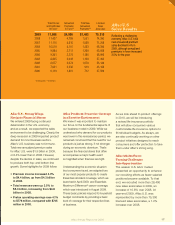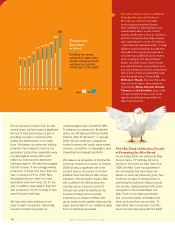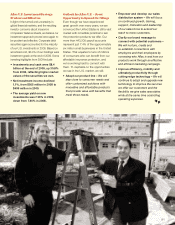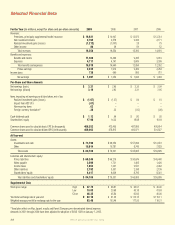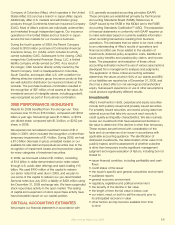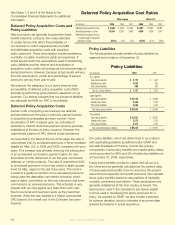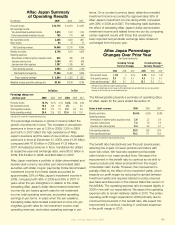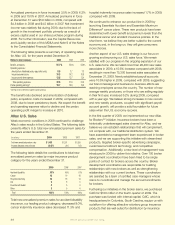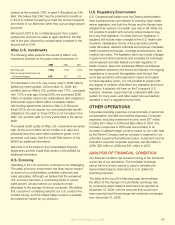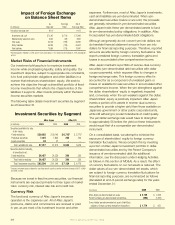Aflac 2009 Annual Report Download - page 31
Download and view the complete annual report
Please find page 31 of the 2009 Aflac annual report below. You can navigate through the pages in the report by either clicking on the pages listed below, or by using the keyword search tool below to find specific information within the annual report.
Unpaid policy claims include those claims that have been
incurred and are in the process of payment as well as an
estimate of those claims that have been incurred but have
not yet been reported to us. We compute unpaid policy
claims on a non-discounted basis using statistical analyses
of historical claims payments, adjusted for current trends
and changed conditions. We update the assumptions
underlying the estimate of unpaid policy claims regularly and
incorporate our historical experience as well as other data
that provides information regarding our outstanding liability.
Our insurance products provide xed-benet amounts per
occurrence that are not subject to medical-cost ination.
Furthermore, our business is widely dispersed in both the
United States and Japan. This geographic dispersion and
the nature of our benet structure mitigate the risk of a
signicant unexpected increase in claims payments due
to epidemics and events of a catastrophic nature. Claims
incurred under Aac’s policies are generally reported and
paid in a relatively short time frame. The unpaid claims
liability is sensitive to morbidity assumptions, in particular,
severity and frequency of claims. Severity is the ultimate
size of a claim, and frequency is the number of claims
incurred. Our claims experience is primarily related to the
demographics of our policyholders.
As a part of our established nancial reporting and
accounting practices and controls, we perform actuarial
reviews of our policyholder liabilities on an ongoing basis
and reect the results of those reviews in our results of
operations and nancial condition as required by GAAP.
In computing the estimate of unpaid policy claims, we
consider many factors, including the benets and amounts
available under the policy; the volume and demographics
of the policies exposed to claims; and internal business
practices, such as incurred date assignment and current
claim administrative practices. We monitor these conditions
closely and make adjustments to the liability as actual
experience emerges. Claim levels are generally stable from
period to period; however, uctuations in claim levels may
occur. In calculating the unpaid policy claim liability, we
do not calculate a range of estimates. The table at the top
of the page shows the expected sensitivity of the unpaid
policy claims liability as of December 31, 2009, to changes
in severity and frequency of claims. For the years 2007
through 2009, our assumptions changed on average by
approximately 1% in total, and we believe that a variation
in assumptions in a range of plus or minus 1% in total is
reasonably likely to occur.
The table below reects the growth of future policy benets
liability for the years ended December 31.
The growth of the future policy benets liability in dollars
has been primarily due to the aging of our in-force block of
business and the addition of new business in Japan. This
growth in dollars was offset in 2009 by the weakening of the
yen against the U.S. dollar, however it was enhanced by the
strengthening of the yen against the U.S. dollar in 2008 and
20 07.
Income Taxes
Income tax provisions are generally based on pretax
earnings reported for nancial statement purposes, which
differ from those amounts used in preparing our income
tax returns. Deferred income taxes are recognized for
temporary differences between the nancial reporting
basis and income tax basis of assets and liabilities, based
on enacted tax laws and statutory tax rates applicable to
the periods in which we expect the temporary differences
to reverse. The evaluation of a tax position in accordance
with GAAP is a two-step process. Under the rst step, the
enterprise determines whether it is more likely than not that
a tax position will be sustained upon examination by taxing
Sensitivity of Unpaid Policy
Claims Liability
(In millions) Total Severity
Decrease Decrease Increase Increase
Total Frequency by 2% by 1% Unchanged by 1% by 2%
Increase by 2% $ – $ 22 $ 44 $ 66 $ 88
Increase by 1% (21) – 22 44 66
Unchanged (43) (22) – 22 44
Decrease by 1% (64) (43) (22) – 22
Decrease by 2% (85) (64) (43) (21) –
Future Policy Benets
(In millions of dollars and billions of yen) 2009 2008
2007
Aflac U.S. $ 5,779 $ 5,442 $ 4,958
Growth rate 6.2% 9.8% 12.9%
Aflac Japan $ 55,720 $ 53,866 $ 40,715
Growth rate 3.4% 32.3% 11.7%
Consolidated $ 61,501 $ 59,310 $ 45,675
Growth rate 3.7% 29.9% 11.8%
Yen/dollar exchange rate (end of period) 92.10 91.03 114.15
Aflac Japan ¥ 5,132 ¥ 4,903 ¥ 4,648
Growth rate 4.7% 5.5% 7.1%
Aflac Annual Report for 2009 27


